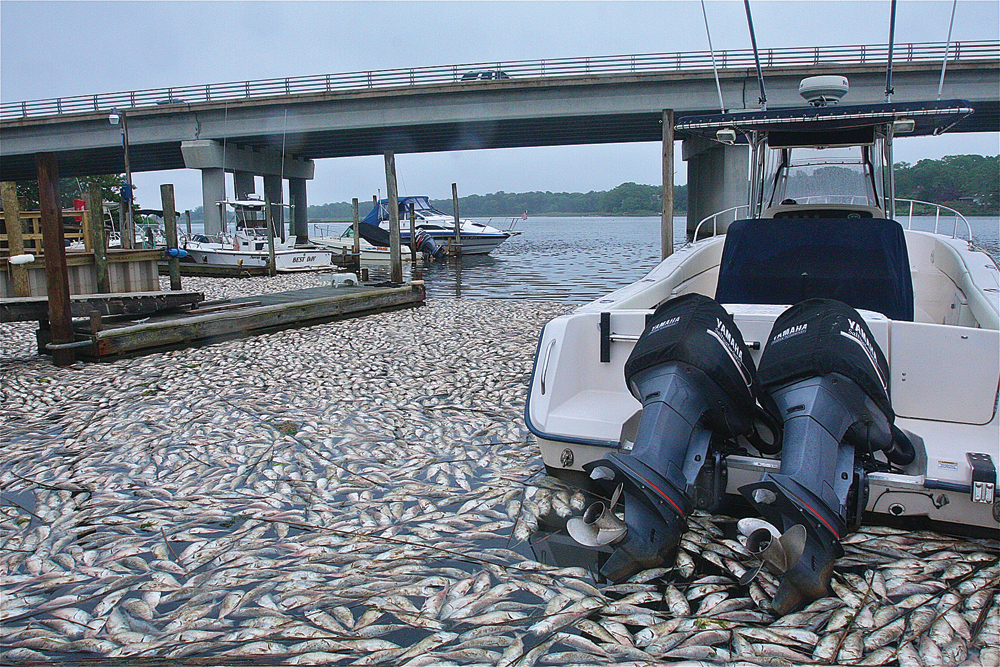Column: More fish kills are coming … so says one researcher


Here’s a prediction you’ll probably hope is wrong.
A marine researcher from Molloy College in Rockville Centre is predicting that a massive fish and turtle kill will occur in the Peconic Bay within the next week or so. Just like it was predicted last year.
Sixto Portilla, an adjunct lecturer in organic chemistry and oceanography at Molloy, where he runs the marine lab, emailed us last week with his prediction, offering to explain further.
So I called him back.
I was a little worried I might be in over my head when the first thing he did was ask about my chemistry background, which basically ended in high school.
Mr. Portilla doesn’t agree with the theory that last summer’s fish kills were strictly the result of low dissolved oxygen in the bay, caused in part by nitrogen loading from cesspools and fertilizers and so on that led to the creation of algal blooms.
“I’ve read the stories too and I don’t agree with them,” he said.
Instead, Mr. Portilla thinks the bay’s low dissolved oxygen levels were more the result of dead and decaying fish — not the other way around.
And that theory is what has led him to his fish kill prediction.
Temperature readings from the U.S. Geological Survey’s tide gauge by the County Road 105 bridge last year showed some major temperature drops between May and mid-June, about 10 days before the fish kills, he said.
In lab tests Mr. Portilla performed on hard clams, the clams’ fates depends on their diet when temperatures drop.
“If they’re given a diet that is not conducive to their adaptation to low temperature, they die — and in very high numbers,” he said. But if they have a diet that is compatible with cold water, they’re OK.
Specifically, according to Mr. Portilla’s theory, when there’s a rapid drop in temperatures of 3 to 5 degrees Celsius, the food supply is the determining factor in whether bunker will begin to die off.
When the water contains an abundance of flagellates, which are rich in an Omega-3 fatty acid called DHA, they are in the clear, he said.
But when the water is rich in diatoms, a type of micro algae that’s high in a less-saturated type of Omega-3 fatty acid called EPA, they die.
Mr. Portilla said testing he did around the USGA tide gauge on April 5 of this year showed large amounts of diatoms. According to his theory, that’s bad news for bunker.
Remember when I said Mr. Portilla asked how much chemistry I knew? Well, I didn’t mention that I didn’t really learn anything in high school. I just took the class.
And at one point during my interview with Mr. Portilla, it’s wasn’t looking good for the bunker or for me.
“No … I don’t think you’re getting it,” he said after I read him back my notes. “It sounds to me like you’re not picking up some of the key points here.”
I felt bad, but Mr. Portilla agreed to send me some materials he’d written on the topic, so I could read them and get back to him.
In the meantime, I went over the notes from our conversation, and I think I’m getting the gist.
Mr. Portilla’s email arrived a few days later with sentences like this: “Inverse correlations emerged between mortality and dietary abundance of 20:5n-3 during the upper range of the temperature decline (18°–12°C), and 22:6n-3 during the lower range (12°–6 °C), demonstrating their unique roles in supporting homeoviscous adaptation within each respective phase of thermal decline.”
To get a better handle on what Mr. Portilla was telling me, I googled “flagellates” and “diatoms.”
The first listing for flagellates came from Wikipedia and the first line read: “Not to be confused with flagellation or fellate.”
After carefully piecing together all the scientific terms with their English equivalents, I emailed Mr. Portilla, who said that in a nutshell, what I wrote is accurate — except I left off the theory that when the temperature is greater than 12 degrees Celsius, diatoms are good for the prevention of hypothermic stunning. And flagellates in temperatures below 12 degrees Celsius are generally high in DHA, which is good.
Another thing happening is that there are already lots of bunker in the Peconic, something apparently taking place earlier than usual. You only need to go to the back of the Route 24 McDonald’s parking lot to hear them jumping in and out of the water. And if you take a picture of the river at night, using a flash, you can actually see them in the photograph.
I bounced Mr. Portilla’s theory off Kevin McAllister, founder of Defend H20 and the former Peconic Baykeeper. He said he’d like to read more into the theory, but agreed that it’s not just a problem of low dissolved oxygen because the turtles that died last year breathe air. He feels, as other researchers do, that a bio-toxin in the food chain is to blame.
So anyway, in about a week, we’ll know if Mr. Portilla’s theory is right or wrong. Good luck, bunker and turtles.
Photo Caption: Dead fish at the Riverhead Yacht Club last year. (Credit: Barbaraellen Koch)




